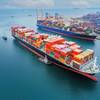“ProteOMZ” Surfaces Findings in Low Oxygen Ocean Waters
Dr. Mak Saito from Woods Hole Oceanographic Institution, along with his research team have just returned from a 22 day expedition, called “ProteOMZ”, aboard Schmidt Ocean Institute’s research vessel Falkor. During this voyage the team implemented the first large-scale deployment of a new protein biomarker technology. The “targeted metaproteomics” approach will be used to diagnose marine microbial populations and their interaction with ocean chemistry.
Using underwater pumps, the upper 1 kilometer of the ocean’s microbial microbiome was sampled by filtering 85,000 liters of seawater over a 7,000 kilometers transit from Hawaii to Tahiti.
The voyage on R/V Falkor focused on measuring and describing the biological and chemical processes that occur in low-oxygen areas of the ocean called oxygen minimum zones. Located in the Pacific Ocean between Hawaii and Tahiti is the largest oxygen minimum zone in the world, and this was the focus of the investigation.
The new method developed by the Saito laboratory and with roots in emerging biomedical methods, has the capability to identify the biochemical functions and environmental stresses acting on the major abundant microbial populations, allowing a diagnostic capability for detecting changes in ocean diversity and function.
“The amount of data that will be obtained from each water sample is staggering”, said Saito. “The team will approach the task starting with the organisms that they know the most about, and working the general picture from that point. It is hoped that this large dataset will become a valuable resource for others studying a variety of ocean processes and topics”.
Dr. Mak Saito anticipates that the research will provide a better grasp of the critical chemical processes being conducted by microbial organisms that live within oxygen minimum zones, and could eventually help to identify long-term changes in these poorly understood regions. Additionally, because the expedition occurred during a strong El Niño year, the samples gathered will allow for studies on how the warmer seawater conditions influence key microbial processes. Comparisons of this dataset with more typical years could provide valuable insight into ecosystem responses to El Niño.
Additionally, this was the first expedition to have the collected data interpreted by a fiber artist. Michelle Schwengel-Regala, Artist-at-Sea participant, knit the water sample data sets providing a unique platform for telling a story about the research. Michelle is the second artist to participate in Schmidt Ocean Institute’s new Artist-at-Sea program.
For more information about the expedition, visit http://www.schmidtocean.org/story/show/5414.












